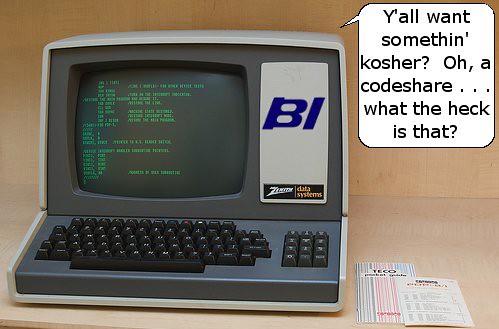For years we’ve heard Southwest talk about how its reservation system was preventing the airline from doing all sorts of things. International flying and codesharing are the big two that have been publicly discussed lately, but there are more things that can’t be done because of its ancient system. Despite these issues having been raised for years and year, we’re still at least three years away from a new system coming online. At Media Day last week, I sat with Bob Jordan, EVP Strategy and Planning at Southwest, to better understand why this was taking so friggin’ long.
But first, how about a little history? Southwest’s reservation system is known as SAAS. This system actually evolved from the old Braniff Cowboy system. Now, Braniff was an airline that had style but absolutely no network planning abilities. After some insane route expansion after deregulation and a whole host of other issues, Braniff collapsed in May 1982. I was four years old at the time. When Braniff died, Southwest ended up carrying the torch on a version of that reservation system, so yes, it’s old and it’s not built to handle an airline in today’s industry.
Bob explained that while it’s problematic today, for the longest time it was perfect for Southwest. Southwest was a simple airline and as the major user of the SAAS system, it could make any changes it wanted as long as it wanted to invest the time and effort. It was effectively a customized reservation system, one that Braniff agents probably wouldn’t recognize today. But as Southwest became more complicated, so did the reservation system. As Bob explained:
As we started to evolve our business model, we really put our first big strategic plan together in ’06. We looked at, well, we need to think about our boarding, think about new products, think about codeshares, think about international, think about having the ability to do complicated fare rules, stays, and all that. . . . You have to sit back and re-evaulate.
And so Southwest did re-evaluate, but it kept coming to the decision to continue modifying this patchwork of a reservation system to make it do what it wanted to do. Despite the fact that there was a mounting problem with being able to handle everything, Southwest stayed the course. But it did have a project together to try to figure out what to do in the future. That project just kept getting delayed.
The other thing that’s happened in the last 3 years specifically, the project has been re-prioritized. Fuel prices spiked, the economy went into the toilet, and so in light of those facts, we interrupted a lot of things and said, we need to pursue reservations but we need to stop and build some things that will add revenue production now, like Business Select, like EarlyBird check-in, and a bunch of revenue management things under the covers that are being pursued that are generating a lot of money.
So the reservation system problem continued to fester. They continued to modify SAAS to be able to handle more of these revenue projects, but the system just couldn’t handle everything. Yet the project to really address this issue kept being pushed back until this year. Though I thought there was a decision to get a new system long ago, Bob says that’s not the case.
The question became whether to continue to build on SAAS versus whether it would be available on Sabre, on Amadeus. That discussion started early this year and we came to a decision early summer that the right thing to do was move instead of continuing to build. Then it became, move where?
Having finally made the inevitable decision to move to a new system, now Southwest had to pick which one. And that still hasn’t happened. After the AirTran acquisition was announced, Southwest said it had narrowed the finalists to two vendors, and I can’t imagine AirTran’s vendor is one of those. AirTran uses Navitaire’s New Skies system. That system has more capabilities than the previous Open Skies system, but it is still limited. That’s why we’ve seen airlines like JetBlue leave Navitaire for others, Sabre in JetBlue’s case. They need more complexity, and Southwest needs that now too.
But what’s the timing now? It’s going to be a long time. Now that Southwest has to integrate AirTran, this might delay the new system even longer so that they can work to integrate AirTran first. And then there’s the problem of AirTran’s existing international business. How will they handle that in the meantime?
We’re working on that. We’ve got timing options. International works on Navitaire and we could pursue an option that basically continues to use Navitaire for international but connects SAAS to that, or we could pursue an option where we move the international business first to the new platform.
In other words, it could be a mess for awhile. But once the decision on the vendor is made, hopefully soon, and the project is ready to commence, we still have a long way to go.
It’s probably an 18 to 24 month project once you start, probably 24 month range. We’ve got probably up to a year’s worth of work to complete our requirements gathering and planning before we begin to execute so it’s in the 36 month timeframe.
What we now see at Southwest is an airline that will continue to be hamstrung by its reservation system for years to come. Had it made the decision to switch earlier or kept the project at a high priority, then I’m sure this would be much further along, but now Southwest has to live with electronic handcuffs for a lot longer. And that can’t be good for the business, but, well, they set the priority so they apparently feel comfortable with this timeframe.
Photo via Flickr user ajmexico/CC 2.0[]

